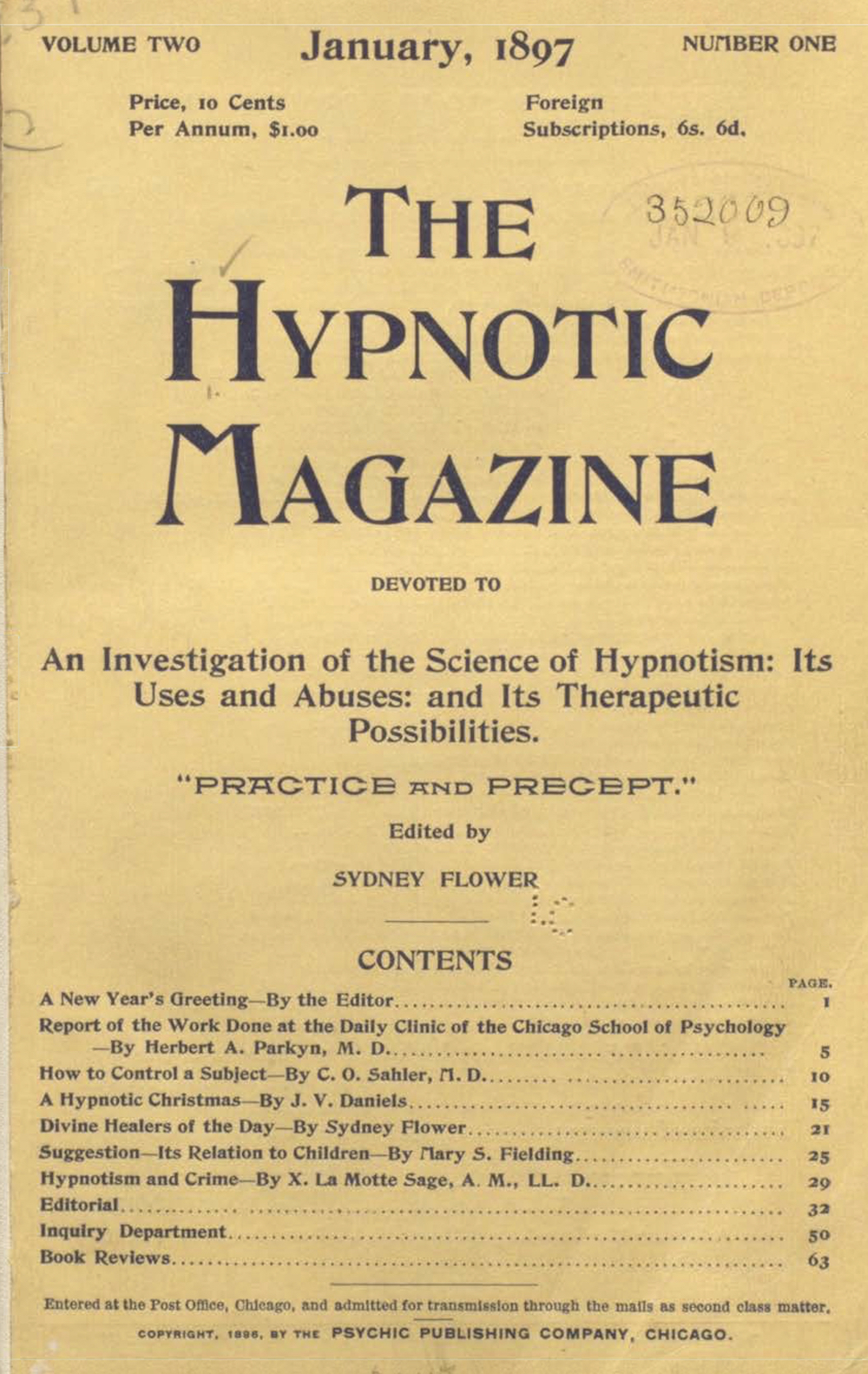

|
| About | Archives | Practices | Contribute | Contacts | Search |
| Periodical: | The Hypnotic Magazine |

|
|
| Summary: |
From Pat Deveney's database:
Hypnotic Magazine, The. Sydney Blanshard Flower (1867-1943), the editor of this journal, was, along with a few others in the two decades before the First World War, like A. Victor Segno of the Segnogram, and Charles E. Ellis of the Magazine of Mysteries, exemplary of the hucksters and confidence men who combined the fundamental realization of New Thought (the power of mind over self and the environment) with mail-order marketing, modern advertising, bulk mail rates, and a fine disregard for legal niceties and honesty. He was born in England, as Marc Demarest has discovered, and immigrated first to Canada where he worked as a journalist and then moved, in 1895, to Chicago where he acted as the manager (and publicist) for Dr. Herbert Arthur Parkyn, another Canadian expatriate, whom Flower may have known in Toronto. The two were part of the influx of Canadian journalists and publishers into American New Thought (John W. Lovell, Fred W. Burry, B.F. Austin, John Emery McLean, Charles Brodie Patterson, et al.) and they devoted their energies to exploiting the then-current wave of interest in hypnotism and suggestion. Flower's first book, Hypnotism Up to Date (1896), published before this journal was begun, consisted of a series of interviews with Parkyn--a promotional model Flower was to later to adopt in touting a scheme to transplant goat glands into men (and women) to increase vigor. Parkyn was a medical hypnotist and suggestive therapist--the latter being a person who used suggestion to influence the unconscious ("subjective mind") that was responsible for disease and failure. He advertised himself as lecturer on Psycho-Therapeutics in the Illinois Medical College and ran his own Chicago School of Psychology on the South Side. In coming years he came to fill the Chair of Suggestive Therapeutics in J.C.F. Grumbine's College of Psychic Science and Unfoldment and ran the University of Psychic Science in Chicago at which William Walker Atkinson taught when he first arrived in the city and which published Atkinson's first books. In 1898, Parkyn began his own journal, Suggestions / Suggestion, which attracted Atkinson as editor in 1900 before he moved on to Flower's very influential The New Thought. Parkyn was a good teacher for Flower, using Suggestion in the early 1900s, for example, to tout, among other dubious ventures, the stock of a land scheme (Motzorongo) in Mexico that Parkyn was interested in -- another model Flower was to follow repeatedly in coming years. The Hypnotic Magazine was begun as the house organ for Parkyn's Chicago School of Psychology, of which Flower was secretary, which had been started in June 1896 to teach suggestive therapeutics, in classroom lessons and Dr. Parkyn's clinics, awarding every graduate a diploma with blue ribbon to hang on his wall. The journal was intended "to contain a complete record of the cases handled up to date and the results accomplished" and it emphasized the clinical, medical side of suggestion and hypnosis rather than the psychic elements (clairvoyance, telepathy, psychometry, and the like) that increasingly came to the fore in the field and effectively separated the medical/academic side from magical New Thought. Psychic elements, to the extent they appeared in the journal at all, were confined to the advertisements, as Fred Nadis has noted, while Flower as editor was openly skeptical about the occult, spiritualism, Theosophy ("an entertaining piece of foolery!"), mental healing, Christian Science, and the like. He included, for example, an article that pointedly asked: "If matter is but a manifestation of mind; if mind forms the body; if mind is only thought with purpose; if thought changes matter at will; why do some of our most advanced metaphysicians permit themselves to be afflicted with baldness?" He also scoffed at the stage "Professors" who were dominating the wave of interest in hypnotism at the time, although he later published Leonidas's Stage Hypnosism: A Text Book of Occult Entertainments (1901), and A. Virgil Neal ("Xenophon LaMotte Sage"), one of the most prominent stage hypnotists, regarded him highly--as well he might, since the two pursued very similar careers as New Thought hucksters, though Sage's led to wealth and Flower's to repeated clashes with the law and obscurity. Flower's approach to the psychic was to change markedly in his subsequent journals as he realized the financial rewards offered through magical New Thought, and by 1899-1900 he was selling vast series of lessons on mind reading, somnambulism, absent treatment, power through clairvoyance, personal magnetism, etc., and had expanded into dietetics and strange devices like the telepascope and the hypnoscope. Contributions by Parkyn, Flower, Thomson Jay Hudson (whose theory of the "two minds in man" provided the journal's basis for suggestive therapy), James R. Cocke, George Wyld, and various physicians, and regular reports from the various Schools (or Colleges) of Suggestive Therapeutics that Parkyn was establishing nationwide (approximately a dozen seem to have existed) in an effort to franchise his methods of suggestive therapeutics. The journal was the first of a series of New Thought and other journals edited by Flower into the 1920s, all increasingly devoted to separating the gullible from their money. Crabtree (1402, 1409); LOC; NYPL. |
| Issues: | The Hypnotic Magazine V1 1896 |
| The Hypnotic Magazine V1 1896 Covers | |
| The Hypnotic Magazine V2 1897 | |
| The Hypnotic Magazine V2 Covers |
|
|